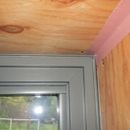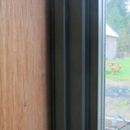Air sealing windows
I am building a Passive House with double stud walls and all OSB seams sealed with Prosoco Joint and Seam filler. I have plywood window bucks and triple pane windows with nailing flanges installed on the exterior of the rough opening. I need to air seal the inside of the window frame to the plywood window bucks. I would like to fill the space between the window frame and the plywood with foam and then air seal.
I have seen expanding foam at my local box store from Great Stuff, DAP and Hilti. Is there any difference between them? Most gaps are small, from 1/4 inch to 1/2 inch max. I would like it to remain flexible over time and to be a closed cell foam.
After filling the space with foam, I plan to trim the excess so that the foam is flush with inside of the window frame. For air sealing, my plan is to use either Prosoco’s Air Dam or Siga tape. One problem is that the inside of the window frame is not flat, there is a lip around the edge of the window, then an indentation, then the frame is flat. As a result, there is not much space for the Air Dam or tape to adhere to. Will the Air Dam even adhere to the foam? The edge of the window is hard to describe, so I have attached to pictures.
I would appreciate any suggestions on insulating the gap with foam and air sealing the windows.
thanks,
Gerald
GBA Detail Library
A collection of one thousand construction details organized by climate and house part











Replies
Gerald,
It sounds like you are doing a conscientious job.
I'm not aware of any significant performance differences between brands of canned spray foam. As you probably know, canned spray foam greatly reduces air leaks, but is not 100% airtight. It's a good idea to use a European tape on the interior, as you are planning.
Another possibility -- especially for the smaller cracks that are closer to 1/8 inch than 1/4 inch -- is to seal the gap between the window frame and the rough opening with silicone or polyurethane caulk.
Most interior jamb extensions are trimmed out with either 1/2-inch gypsum drywall or 3/4-inch trim lumber. That's the dimension that will be covered by trim -- so your tape can overlap the window frame by 1/2 inch to 3/4 inch without the tape being seen. You may also want to shim out the rough jamb before you install your wallboard trim or board trim -- and the thickness of your shims will give you additional thickness to hide the tape.
see http://hammerandhand.com/best-practices/manual/3-windows-doors/3-1-new-window-installation/
If you use a sealant, I suggest a Silyl-Terminated-Poly-Ether (Prococo's air dam) over silicone or polyurethane. Don't use canned foam as your backing for the sealant, use backer rod. See http://hammerandhand.com/best-practices/manual/2-sealant-joints/2-1-sealant-joint-design/
Mask off your window edge, install backer rod then sealant.. In the future I suggest a 1/2'' gap instead of 1/4'' gap as this will give you a more durable sealant joint.
I also suggest if you are using Prosoco's liquid flashing system for windows its best to use their whole system.
One option is to use <a